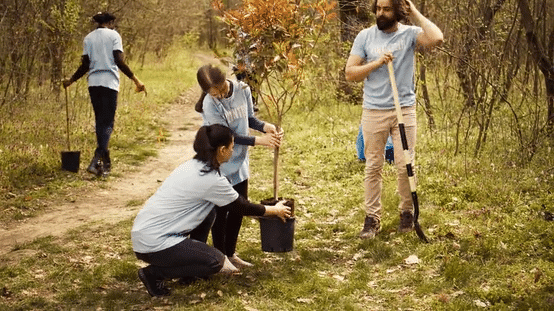
May 08, 2024 Global Trees and Climate Change
As a graduate student at Yale University School of Forestry, Thomas Crowther was intrigued by a question his roommate was asked: how many trees were on Earth? While his roommate didn’t see the significance of the question, Crowther took up the challenge of using a big data approach to find the answer. He discovered that many governments had extensive data sets on their forests. He collected and correlated 400,000 data points on tree density and various ecological variables such as rainfall, latitude, and soil types. He then estimated tree numbers in regions with little available data, including much of Africa and Asia. Crowther and 37 colleagues published their findings in a 2015 paper in the journal Nature, estimating that there were approximately 3 trillion trees worldwide – an order of magnitude greater than previous estimates. This groundbreaking study has been cited over 500 times to date.
Four years later, in 2019, the Crowther Laboratory published an article in Science that suggested that the earth could support an additional 1.2 trillion trees which could potentially absorb around two-thirds of the carbon emissions released by humans into the atmosphere once they mature. This paper received significant media attention, with Carbon Brief reporting it as the second-most mentioned climate paper by public media in 2019, and it has been cited over 1,700 times. However, many of the citations were critical. Science covered the controversy in a news story entitled “Catchy findings have propelled this young ecologist to fame–and enraged his critics.” The same issue included three technical comments challenging the conclusions of the 2019 Crowther Laboratory article, along with a response from the Crowther Laboratory.
The following revisions were included in the response from Crowther Laboratory in Science:
- The authors made it clear that their intention was not to suggest that tree restoration is the sole solution to address climate change. They have also removed any such implications from the article abstract. The authors acknowledged that addressing climate change is a complex issue that requires a combination of approaches for effective mitigation.
- The original analysis aimed to demonstrate that tree restoration could be a more effective mitigation solution than commonly assumed, capable of capturing over 200 gigatonnes of carbon at full maturity.
- It is crucial to address not only tree restoration but also fossil fuel use, deforestation, and forest degradation to reduce greenhouse gas emissions.
Crowther gave a presentation at COP 28 in Dubai where he advised against planting large plantations of fast-growing trees, as they are not as environmentally beneficial as they are often claimed to be. The Crowther Laboratory has been advocating for the preservation of intact woodlands, which have the potential to absorb an additional 139 gigatonnes of carbon if allowed to grow to maturity. Additionally, the laboratory recommends restoring destroyed or fragmented forests which have the capacity to absorb 87 gigatonnes. It’s worth noting that these estimates exclude urban areas, farmland, and grazing areas unlikely to be returned to nature. The revised estimates have received less criticism, but concerns about the duration of forest restoration to remove carbon from the atmosphere remain.
The story of tree restoration and climate change has several takeaways. Firstly, big-picture numbers, such as the estimated number of trees on Earth, gain significant media attention. Secondly, media attention can have both positive and negative consequences. Research scientists often keep the media at bay and disapprove of scientists who appear too media-friendly. However, if one is fortunate, media attention can lead to funding support. In the case of Crowther, the estimation of the global number of trees caught the attention of a Dutch foundation, DOB Ecology, which funds long-term ecological research projects. The foundation invited Crowther to apply for a grant, but his first attempt was unsuccessful as it was not ambitious enough. The second proposal for annual funding of the Crowther Laboratory was successful, and Crowther received a multi-year, multimillion-dollar grant for the laboratory. Other funders have also provided funding, and the Crowther Laboratory in Zurich now has significant resources to explore a range of big-picture ecological projects.
Restor is a project created by the Crowther Laboratory and powered by Google Earth Engine and Google Cloud. It is an open-source platform that supports and connects the global restoration movement through a map-based interface. Restor allows citizen ecologists, or more accurately – citizen ecologists, to report on nature restoration projects of all sizes, and to date, it has registered almost 100,000 restoration and conservation initiatives. Close to Washington, DC, there are four registered projects, including a 0.16-hectare urban garden in Rockville, a 91-acre reforestation program in the Chesapeake Bay catchment area, a 0.77-hectare marsh preservation project managed by the Nature Conservancy, and a 3.82-hectare wetland restoration project by St. Paul’s Kent Episcopal Church. Although it will be challenging to draw conclusions from such a varied collection of projects, Restor has significant potential.
WBI suggests that finding the most efficient solutions to global environmental challenges should involve an open and constructive exchange of ideas and proposals, which can lead to the creation of effective new programs and enhancements of existing ones. The discussion regarding the role of trees in mitigating climate change, as explained earlier, is a perfect example of this. WBI commends “Science” for providing a forum where diverse perspectives and arguments can be presented in a timely manner.


